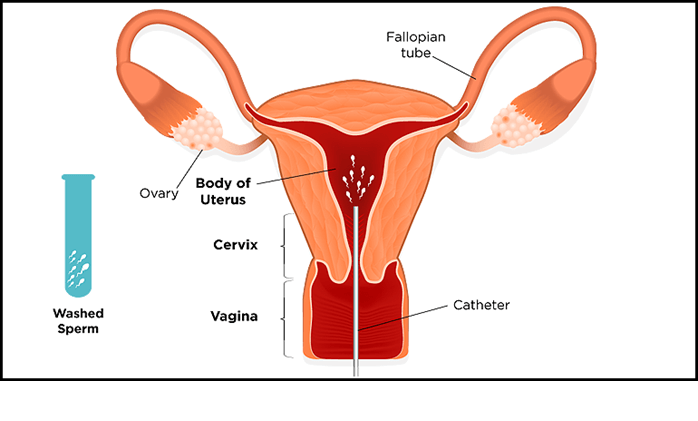Intra uterine insemination (IUI) is the process of inserting processed sperms in the uterus near the fallopian tube to assist fertilization IUI is the basic treatment of infertility. It starts with ovulation induction followed by a LH trigger, post which semen sample is collected from the male partner, washed and inseminated in the wife’s uterus. The growth and the rupture of the follicles in monitored on ultrasound. Tubal patency is essential while doing IUI treatments, which are generally checked on X-ray or during a diagnostic laparoscopy.
STEPS INVOLVED DURING IUI
1. Ovulation Induction
Starts from day 2 of the patients periods, she is given medication to grow more than one follicle. When the follicle size becomes 18 – 20 mm , a rupturing trigger is given to the female partner post which IUI is performed.
2. Semen Preparation
The semen sample is washed in a media chosen depending on the semen count. The washed sample of then centrifuged to collect highest concentration of sperms in minimum amount of media, this is then loaded in a Catheter.
Insemination
Some clinics do IUI once post or pre rupture, however at AdBaby IVF we usually do IUI twice pre and post rupture follicular rupture and thus giving our patients a higher chances of conception.

Follicular Study
A womens ovary has 6 million oocytes at puberty. At every menstrual cycle a group of antral follicles, 10-15 in number start growing. An antral follicle consists of an oocyte (female egg) surrounded by granulosa and theca cells (two types of cells)- which nourishes the oocyte and secrete female hormone called estrogen. As estrogen collects around the oocyte the antral follicles look like small fluid filled cysts.
They grow at a rate of 2 mm per day, by the 5th or 6th day of menstrual cycle, majority of these antral follicles undergo artesia and only one grows. This growing follicle can be seen by Transvaginal ultrasound daily- This is called follicular study. The study starts around 8th to 10th day of menstrual cycle and continues till the follicle ruptures. It usually ruptures after it achieves 20 mm size.
In regularly menstruating women, follicle ruptures 14 days before expected menses; that is follicle will rupture on 16th day in a woman who has 30 days cycle. With rupture of the follicle, oocyte with few granulosa cells falls out of the ovary and is picked up by the fallopian tube.
What is follicular study?
Follicular study is the procedure in ehich the follicle size is checked on ultrasound from the 2nd day to 14th or 15th day of periods. this is done to track thr growth of the follicle in the ovaries. Only a follicle above the size of 20mm will release a mature egg which will help us achieve pregnancy.
How many times do i have to visit the clinic during folicular study?
There will be 4 to 5 visits to the clinic in a span of 15 days. If you have done follicular study before the doctors will know the growth pattern of the follicle hence number of visits can be reduced.
How is follicular study done?
The best way to perform folicular study is through a transvaginal sonography, during this the ultrasound picks up the images of the follicle and gives us the most accurate size of the growing follicles. Thew image below shows how the scan is seen

As seen in the picture on the left circular black structures are the follicles in the ovaries. They grow by 2mm everyday and this is verified on follicular study.
Is follicular study painful?
You might feel little discomfort but it is not at all painful.
Who needs follicular study?
Patients who have recently planned to have a pregnancy and want to know their ovulation days(Fertile period), follicular study is the best option.

